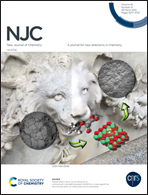Direct conversion of cellulose to ethyl levulinate catalysed by modified fibrous mesoporous silica nanospheres in a co-solvent system
Abstract
KCC-1/Al–SO3H solid acids with different Si/Al molar ratios were prepared by sulphonic acid functionalisation using fibrous nanoporous silica particles (KCC-1/Al) as carriers. Field emission scanning electron and transmission electron microscopy measurements revealed that the sulphonation did not change the spherical morphology and fibrous structure of KCC-1/Al. The Brunauer–Emmett–Teller (BET) analysis indicated that the BET surface area of KCC-1/Al–SO3H could reach 293–372 m2 g−1, while the average pore size was 7.31–7.43 nm. In addition, pyridine adsorption infrared profiles showed that KCC-1/Al–SO3H contained abundant Lewis–Brønsted acid sites, while based on ammonia temperature-programmed desorption characterisation, a total ammonia desorption quantity of 91 cm3 g−1 could be achieved using a Si/Al molar ratio equal to 5. The efficiency of the prepared KCC-1/Al–SO3H was examined in the synthesis of ethyl levulinate (EL) from cellulose in a mixture of ethanol and toluene. Among them, 5KCC-1/Al–SO3H exhibited superior performance, affording EL in 28.8 mol% yield under the optimal reaction conditions (200 °C, 6 h). Furthermore, a mechanism demonstrating the synergistic effect of the Lewis–Brønsted acid sites was proposed based on the reaction activity of different biomass sugars at the acidic sites.



 Please wait while we load your content...
Please wait while we load your content...